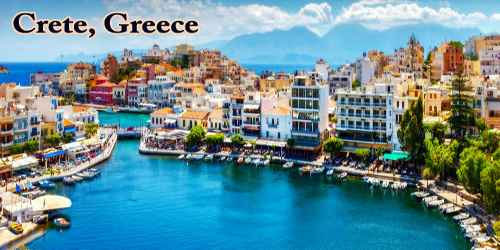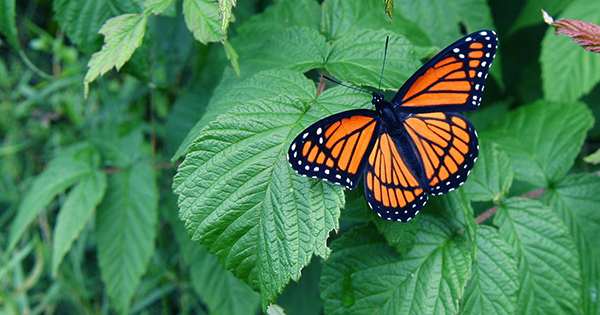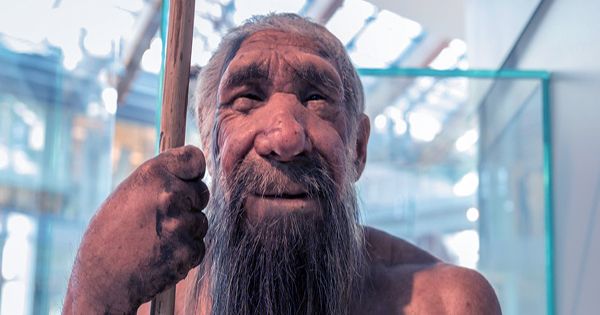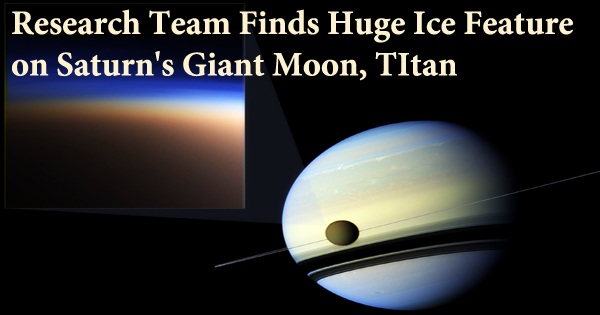Crete (Greek: Κρήτη, Modern: Kríti, (‘kriti), Ancient: Krḗtē, (krέːtεː); Egyptian: keftiu; Biblical Hebrew: כפתור, caphtor, Turkish: Girit) island in the eastern Mediterranean Sea that is one of 13 administrative regions (periféreies) of Greece. It is the largest and most populous of the Greek islands, the 88th largest island in the world, and the fifth-largest island in the Mediterranean Sea, after Sicily, Sardinia, Cyprus, and Corsica. It bounds the southern border of the Aegean sea. Crete lies approximately 160 km (99 mi) south of the Greek mainland. It has an area of 8,336 km2 (3,219 sq mi) and a coastline of 1,046 km (650 mi).
The birthplace of the Minoans, the first advanced European society, and of the Greek god Zeus, Crete is packed with enough history to keep visitors occupied throughout their stay. History buffs need to make sure to visit the Heraklion Archaeological Museum, as the world-class museum is filled with Minoan art and artifacts. Castles, churches, and monasteries also decorate the island and make for interesting visits and excellent pictures.
The island is separated in 4 prefectures: Heraklion, Chania, Rethymno, and Lassithi. The mythical Crete Island is one of the most popular Greek destinations, thanks to its unreal Crete beaches, it’s amazing historical sites, such as Knossos Palace and Spinalonga islet and its mesmerizing natural landscapes.
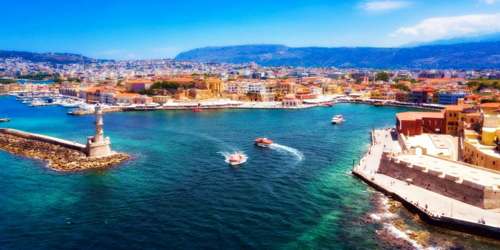
Humans have inhabited the island since at least 130,000 years ago, during the Paleolithic age. Crete was the center of Europe’s first advanced civilization, the Minoans, from 2700 to 1420 BC; the Minoan civilization was overrun by the Mycenaean civilization from mainland Greece. Later, Crete fell under Roman rule, and afterward, the Byzantine Empire, Andalusian Arabs, the Venetian Republic, and the Ottoman Empire successively ruled Crete. The Cretan people, who maintained a desire to join the Greek state, achieved independence from the Ottomans in 1898 as the Cretan State and became part of Greece in December 1913.
The island is mostly mountainous, and its character is defined by a high mountain range crossing from west to east; it includes Crete’s highest point, Mount Ida, and the range of the White Mountains (Lefka Ori) with 30 summits above 2000 meters in altitude and the Samaria Gorge, a World Biosphere Reserve. Crete forms a significant part of the economy and cultural heritage of Greece while retaining its own local cultural traits (such as its own poetry and music). The Nikos Kazantzakis airport at Heraklion and the Daskalogiannis airport at Chania serve international travelers. The palace of Knossos, a Bronze Age settlement and ancient Minoan city, lies in Heraklion in Crete.
Crete is dominated by harsh mountains rising out of the sea. The island’s east-west mountainous range consists of four main groups that rise to the island’s highest point, Ídi mountain, 8,058 feet (2,456 meters) in elevation. To the west, the Lefká (“White”) Mountains reach 8,045 feet (2,452 meters), and to the east, the Díkti Mountains extend to 7,047 feet (2,148 meters) in elevation. Those mountains rise above the high upland plains of Nída, Omalós, and Lasíthi and are marked by several gorges, the best known of which is the Samariá Gorge. The gradually sloping northern coast provides several natural harbors and coastal plains, where such major towns as Chaniá (Khaniá; historically Canea), Réthymno (Réthimnon; historically Rhithymna), and Irákleio are located. The Mesara (Messára) Plain extends along the south-central part of the island for about 18 miles (29 km) and is Crete’s major expanse of flatlands. Sandy and pebble-strewn beaches dot the coastline. Crete has six small rivers as well as springs, seasonal watercourses and ponds, one natural freshwater lake (Lake Kournás), and several artificial lakes.
The current name “Crete” is first attested in the 15th century BC in Mycenaean Greek texts, written in Linear B, through the words ke-re-te (*Krētes; later Greek: Κρῆτες (krɛː.tes), plural of Κρής (krɛːs)) and ke-re-si-jo (*Krēsijos; later Greek: Κρήσιος (krέːsios), “Cretan”). In Ancient Greek, the name Crete (Κρήτη) first appears in Homer’s Odyssey.
In Latin, the name of the island became Creta. The original Arabic name of Crete was Iqrīṭiš (Arabic: اقريطش < (της) Κρήτης), but after the Emirate of Crete’s establishment of its new capital at ربض الخندق Rabḍ al-Ḫandaq (modern Iraklion), both the city and the island became known as Χάνδαξ (Chandax) or Χάνδακας (Chandakas), which gave Latin, Italian, and Venetian Candia, from which were derived French Candie and English Candy or Candia. Under the Ottoman rule, in Ottoman Turkish, Crete was called Girit (كريت).
Crete has rich mythology that is connected to the Minoan civilization and Greek gods. Greek mythology says that Zeus was born at the Diktaean Cave at Mount Dikti, the goddess Athena is said to have bathed in Lake Voulismeni, and goddess Artemis and god Apollo were born at the Paximadia Islands. God Zeus, in trying to protect the island of Crete, would throw a lightning bolt at a giant lizard. This lizard would turn to stone and become the island of Dia.
Throughout the modern period, Cretans have made important contributions to Greek literature. They have their own poetry called Mantinades. There is also Mantinades-based music.
Crete’s climate varies between temperate and subtropical, with annual average precipitation of about 25 inches (640 mm) and hot dry summers. Winter temperatures are relatively mild. The air in the mountains is temperate and cool. Precipitation in that region is much higher than elsewhere on the island, and the mountains are often covered with snow in the winter (November to May), which may remain on the highest peaks throughout much of the year.
The island has an elongated shape: it spans 260 km (160 mi) from east to west, is 60 km (37 mi) at its widest point, and narrows to as little as 12 km (7.5 mi) (close to Ierapetra). Crete covers an area of 8,336 km2 (3,219 sq mi), with a coastline of 1,046 km (650 mi); to the north, it broaches the Sea of Crete (Greek: Κρητικό Πέλαγος); to the south, the Libyan Sea (Greek: Λιβυκό Πέλαγος); in the west, the Myrtoan Sea, and toward the east the Karpathian Sea. It lies approximately 160 km (99 mi) south of the Greek mainland.
Top Attractions of Crete Island, Greece:
- Gramvoussa Castle – Located near the city of Chania. The history of the castle dates back to the 16th Explore the fortress and the views offered.
- Istro Beach – This beach is found near Lassithia. Bluewater and fine sand make this beach enjoyable, not to mention how beautiful the area is. A family-friendly and organized beach.
- Venetian Harbor – Located in the northern part of the island in Rethymno. Tour the old town district and historic castle. Harbor also features a historic lighthouse and old stone walls.
- Historical Museum of Crete – Located in Heraklion. Artifacts and art from the early Christian era to the present. Museum also features two El Greco paintings and Venetian gold jewelry.
- Vai Beach – Found on the eastern side of the island. This beach features Cretan date palm trees and sandy shores. A secluded, well-maintained beach with snack bars and coffee spots on site.
- The Palace of Knossos – The largest and most well-known of the Minoan castles on Crete. One of the seven ancient wonders of the world. Explore the grounds on your own or take a guided tour.
- Minoan Castle – Located in the south-central area of Crete. The smallest of the four palaces on Crete. Great place to learn about Minoan civilization.
- Heraklion Archaeological Museum – Features treasures uncovered at Knossos. Artifacts date back 3,000 years. One of the top exhibits is frescos.
- Moni Preveli Monastery – Was once the center of the anti-Ottoman resistance. Burned by the Turks in 1866. It also served as a shelter during WWII for Allied soldiers after the battle of Crete.
- Preveli Beach – Located below the Moni Preveli Monastery. Palm-lined river banks and clear freshwater pools. This beach sits at the mouth of the Kourtaliotiko Gorge.
Mountains in Crete are the object of tremendous fascination both for locals and tourists. The mountains have been seen as a key feature of the island’s distinctiveness especially since the time of Romantic travelers’ writing. The island has a number of gorges, such as the Samariá Gorge, Imbros Gorge, Kourtaliotiko Gorge, Ha Gorge, Platania Gorge, the Gorge of the Dead (at Kato Zakros, Sitia) and Richtis Gorge and (Richtis) waterfall at Exo Mouliana in Sitia. The rivers of Crete include the Ieropotamos River, the Koiliaris, the Anapodiaris, the Almiros, the Giofyros, and Megas Potamos. There are only two freshwater lakes in Crete: Lake Kournas and Lake Agia, which are both in Chania regional unit. Lake Voulismeni at the coast, at Aghios Nikolaos, was formerly a freshwater lake but is now connected to the sea, in Lasithi. Lakes that were created by dams also exist in Crete. There are three: the lake of Aposelemis Dam, the lake of Potamos Dam, and the lake of Mpramiana Dam.
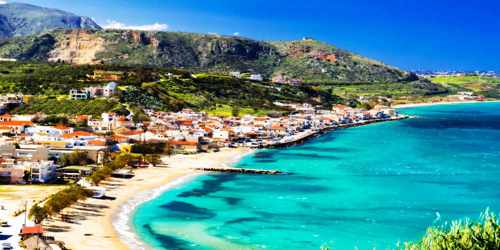
The Cretan landscape is dominated by characteristic Mediterranean scrub (maquis or garigue). Palm trees are intermittent along the coasts, and cedars can be found in the east. An array of plant species (notably flowers) thrive in the moderate climate, many of them native to the island. Hundreds of migratory bird species visit Crete, and there are some small wild animals. The agrími, or wild goat, is found in remote mountainous areas and on offshore islands, where it finds protection in wildlife reserves. Endemic species of wild plants are especially plentiful in and around the Samariá Gorge, the centerpiece of Samariá National Park, in the southern part of the island in Omalós about 26 miles (42 km) south of Chaniá.
Crete’s industry is largely confined to food-processing equipment (grape and olive presses), building materials (quarried stone and marble, processed lime, and building blocks), and a few ceramics, textiles, soap, leather, and beverage-bottling enterprises. Crete has to import all but the most basic items, including fuels. The Gross domestic product (GDP) of the region was 9.4 billion € in 2018, accounting for 5.1% of Greek economic output. GDP per capita adjusted for purchasing power was 17,800 € or 59% of the EU27 average in the same year. The GDP per employee was 68% of the EU average. Crete is the region in Greece with the fifth highest GDP per capita.
Crete was one of the most popular holiday destinations in Greece. 15% of all arrivals in Greece come through the city of Heraklion (port and airport), while charter journeys to Heraklion seven years ago made up 20% of all charter flights in Greece. Overall, more than two million tourists visited Crete some years back, when the increase in tourism was reflected in the number of hotel beds, rising by 53% in the period between 1986 and 1991.
Today, the island’s tourism infrastructure caters to all tastes, including a very wide range of accommodation; the island’s facilities take in large luxury hotels with their complete facilities, swimming pools, sports and recreation, smaller family-owned apartments, camping facilities, and others. Visitors reach the island via two international airports in Heraklion and Chania and a smaller airport in Sitia (international charter and domestic flights starting May 2012) or by boat to the main ports of Heraklion, Chania, Rethimno, Agios Nikolaos and Sitia.
Traditional folk culture survives to some degree in villages and small towns. Song forms such as rizitika and mandinades are accompanied by such traditional instruments as the lyre and lute, and dances include the pentozalis, which is traditionally performed by men; the chaniotikos (sirtos); and the faster, livelier maleviziotikos, sousta, and sitiakos. Pottery making, weaving, and needlecrafts of all kinds, wood carving, and leatherwork are still widely practiced.
Information Sources:
